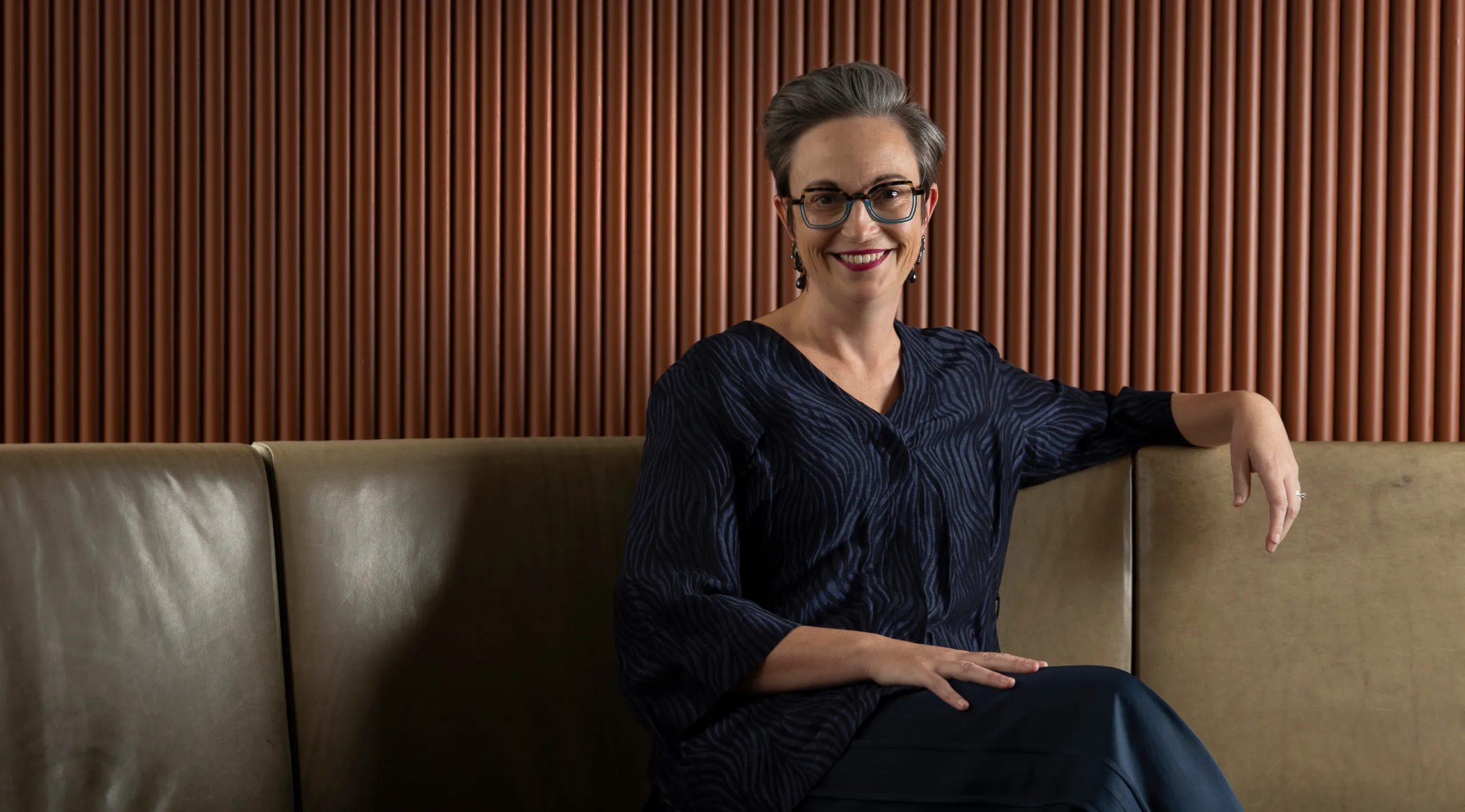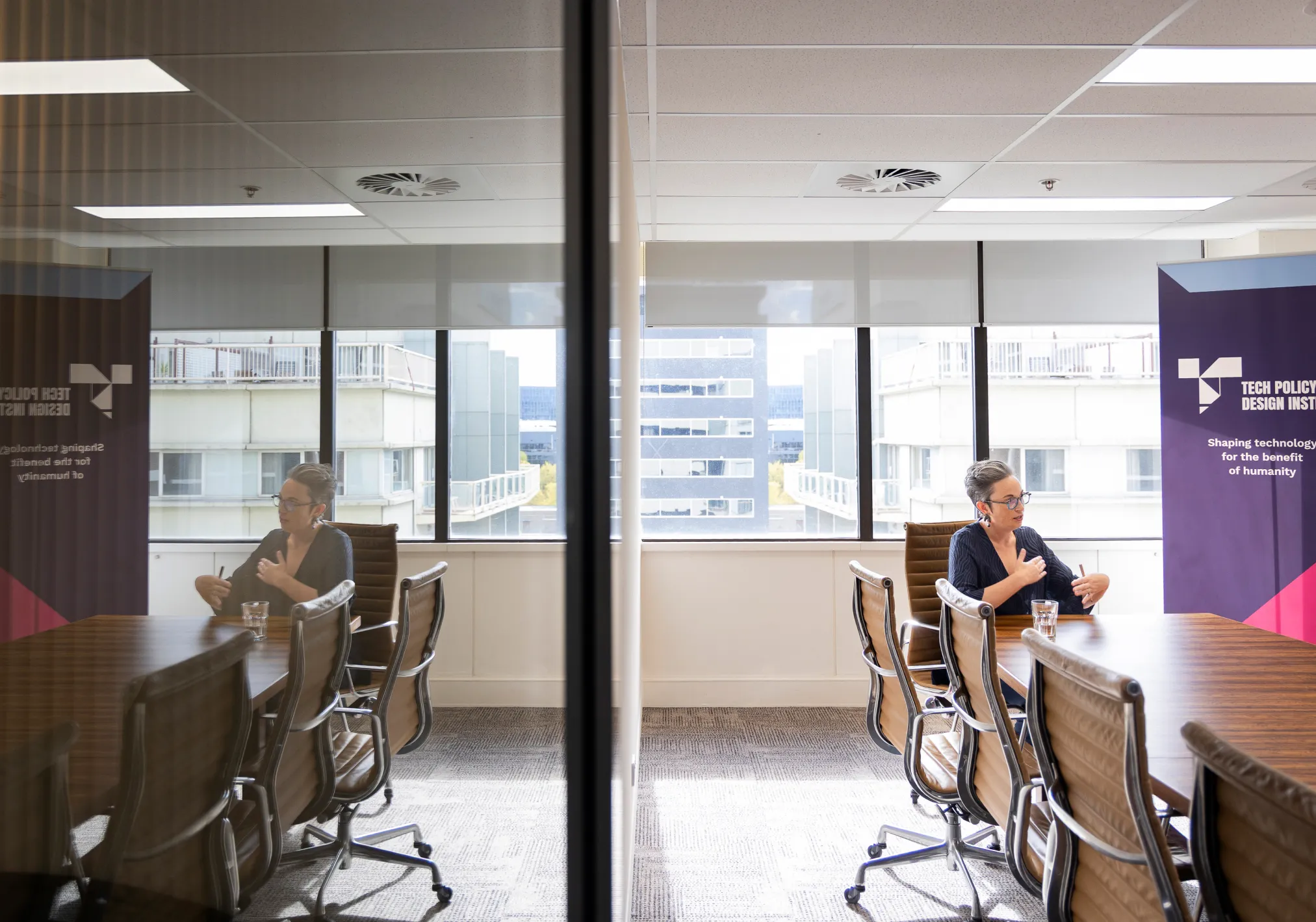The Tech Policy Design Institute is Australia's first independent think tank focused on technology policy.
After three years of incubation at ANU, the Institute launched in January this year to bridge the gap between technologists and policymakers on important and emerging issues in technology.
Before establishing the Institute, Johanna Weaver helped build Australia's cyber diplomacy practice and represented Australia as Chief Cyber Negotiator at the United Nations.
We spoke to Johanna about Australia's unique opportunity to lead in responsible technology amid shifting global dynamics and the need for diverse voices and co-design in technology policy.
Johanna Weaver, Executive Director at the Tech Policy Design Institute
Dan Woods, Head of Partnerships, Canberra

To start, it would be lovely to hear a little about yourself and your background.
I'm the Executive Director here at the Tech Policy Design Institute. I like to say that I'm a reformed litigator, a recovering diplomat and a reluctant public intellectual. My first career in diplomacy ended after a posting in West Africa, where I managed Australia's response to Ebola, and I decided that after that, I needed to have a break. I stepped back and specialised in what I then called strategic cyber policy and ended up back in the Foreign Service and helped to establish Australia's cyber diplomacy practice, looking at how technology is influencing every aspect of foreign policy.
In my role as Australia's Chief Cyber Negotiator at the United Nations I was engaging with governments, literally all over the world, all of whom were struggling with, “We all know that we have to step up and regulate technology. But how do you do it well and how do you do it in a way that brings in the entire ecosystem and harnesses the knowledge and expertise of the multi-stakeholder community as well as government as well as industry.”
And there really weren't very many organisations, particularly in our part of the world, that were actually partnering and working with government on some of those really big challenges. And so, after we managed to get agreement across the line in New York at the UN, I made the decision to step out of government again and established what was then the Tech Policy Design Centre at ANU.
We were incubated at ANU for three years and just in January this year, we've spun out as Australia's first independent think tank dedicated to technology policy. That statement is sometimes considered, people say “are you really the first?” And when we look at it from that perspective we are the only think tank that is dedicated to technology policy issues. There are lots of others who deal with these issues, but dedicated to looking at them solely is our specialisation.
When you talk to folk in government or in the community, do they immediately get what you mean by tech policy?
Well, I think the phrase tech policy has evolved. So when I left government the first time and specialised in what I then called strategic cyber policy, it's actually the same thing as what I now call technology policy. So I think the name evolves, but I think there is broad understanding now of what technology policy is. Technology policy is just public policy that has an element of technology embedded in it, which is almost every single aspect of public policy.
Why we lean into technology policy—and what I'm passionate about—is having anyone who works in the public policy space lean into and not be scared of technology, because I think there's still a reticence to engage with it. It's well, “I do the policy dimension and the technologists do the technology dimension.”
I think that's how things like robodebt happen, right? We actually need to bring those two parts together and have the technologists and the policy makers speaking the same language and that's really what we're passionate about building at Tech Policy Design Institute.
I think that's how things like robodebt happen, right? We actually need to bring those two parts together and have the technologists and the policy makers speaking the same language and that's really what we're passionate about building at Tech Policy Design Institute.
Johanna Weaver

Do you feel a sense of urgency from government? There are so many things happening in technology at the moment.
I think there's a huge sense of urgency not just from government, but also from industry, and from the Australian population. I also think that often, with that sense of urgency, there is a sense of overwhelm. “It's moving too fast. What can I do in this?”
So a big part of what we do is say that we all have agency in how technology evolves. Yes, it's evolving quickly. But it is still made by humans, and we as humans get a say in the shape it takes. I think policy is one of the best tools that we have as non-technologists in order to shape that future, and that is incredibly exciting to me.
Because whilst I am a strong proponent that we need to regulate technology to ensure we're getting good outcomes, fundamentally at my core I'm an optimist about what technology can do for us. But we can't just sit back and wait for technology to deliver good things. We actually have to engage to shape it so that we extract those benefits. We need to make sure we're preventing the harms that we now know come with technology if we're not accompanying that technology and with the right controls or incentives for the companies that are making them.
What does that agency look like if you're a public policymaker versus a member of the community?
If you're a member of the community, the most powerful thing that you can do is to engage with your politicians or the people who are providing you with technology and say, “I want my technology made differently.” That sounds like a really simple statement, but putting pressure on politicians or the companies that you buy technology from really does work. Politicians respond to what their constituents want.
For policymakers, I think it is about accepting that you have the ability to shape policy, and in shaping the policy, you're shaping technology. We have some really powerful examples of that in Australia; the eSafety Commissioner and the legislation that has been put through Parliament, which is now world-leading. Now, of course, there are more things we can do in that space, and we must. But that's a really clear example of how policy is actually shaping technology.
I think people often think about technology policy and regulation as red tape and restraints. An example to counter that is around getting our skilled migration settings right, so that we're attracting the right people into Australia, to build the type of technology that we want and need in Australia.
Not all technology policies are about saying you can't do something. It's often about providing an enabling environment for us to actually create that technology here in Australia.
Do you think the governments here, including state governments, are doing a decent job of balancing the tension between risk and enablement?
That tension got all the more complicated given what's happening in the US.
So, not only are we going to be balancing the tension of the potential opportunity of the technology against what we know are real harms that could come with it. But we're also now going to have to balance that against what the potential repercussions or economic consequences are of, for example, regulating artificial intelligence in Australia, when we have the Trump administration saying that it's something that they would put a tariff on. That level of economic coercion from our biggest ally is something that we've never had to deal with before.
So I think here, the answer is Australia being really clear about what we stand for and recognising that building technology in a way that distinguishes Australia as a country, that builds responsible technology supported by excellent technology policy, is a competitive advantage for us. Back to the skills point, we have an opportunity to attract all of these concerned technologists, and people who have been working in public policy or aid and development, who, at the moment, are thinking, “Okay, there's not really a place for me in the United States.” Let's provide them with somewhere to come to, and do extraordinary things with technology here within that framing of “we're not just building any technology, we're building the technology that is solving the real problems that we need to solve in the world that we have today.”
The challenge that we have now is that, to date, governments have tended to lend more towards a restrictive approach. I think the risk, like we’ve seen with the Trump administration, is that we over-correct to a totally laissez-faire approach. Which is not good for us either. In the middle, there is a real opportunity for Australia to carve out an Australian approach that will be welcomed, and not just in Australia. We're not the only country that's grappling with these challenges.
... we're not just building any technology, we're building the technology that is solving the real problems that we need to solve in the world that we have today.
Johanna Weaver


A really interesting thing is that governments are a centre of power for this, but so are the platforms themselves. These enormous institutions exert a lot of economic and political power. If Australia takes a position of “we're going to build responsible technology, and this is our mission and our vision of how we want to do that.” How do you see the platforms responding?
I think there are two parts to that one. I think privately, whilst there are a number of large tech companies that are very excited by what Trump is doing and are very closely aligning themselves to that, the tech ecosystem is very diverse, and there are also a number of companies that we work with that are very concerned by what is happening.
So I think there's an important distinction to be made. It's not one industry. So, it's about finding the responsible platforms to work with as a first step.
The second part is recognising that obviously Australia can't act alone when we're talking about regulating U.S. platforms or regulating Chinese platforms, and the fact that we're putting them on the same footing is an interesting and really significant development and shift for Australia. That is a mental shift more than anything else.
When we're talking about regulating technology, there is a real desire and need to work in concert with a group of countries who are going to be grappling with this and there's a lot of people who say it's not possible to build a coalition quickly enough in order to be able to respond to this.
And to people who have that view, I would say that most often international agreements are negotiated fast in times of tension and when there is the most need and motivation for parties to do it. An example would be the Christchurch call which was developed after the Christchurch attacks in less than two months and had, I think, around 20 countries that signed up within their first two months and now has 56 countries that have agreed to a series of commitments that hold platforms to account.
I think the dramatic shift that has come both with the transformative impact of artificial intelligence on every other aspect of technology development through our economies and our societies, combined with the transformative shift of Trump presidency will provide that motivation. If countries are willing to step up into a leadership role to bring other countries together to develop regulatory frameworks, we can actually help hold these platforms to account.
Whilst I think it's very clear that regulation has gone out of fashion in the US, I'm quite optimistic about the fact that they may actually help drive a movement among middle ground countries. Countries that don't sit firmly in the laissez-faire camp, don't fit firmly in the authoritarian control camp, but who recognise that technology can bring us really extraordinary things. But we need to make sure we're putting the right frameworks in place.
There's an opportunity for Australian leadership here, because we are known as a country that builds good technology. We actually have street cred in that respect, but we're also known as a country that is engaged in international conversations and debates, and has been taking a leadership role in those conversations and debates in UN organisations, and in other spaces for a long time.
There aren’t many countries that have that combination. There's a clear opportunity for Australia to step up in that space to help rebalance that power, not just rebalance against Trump or rebalance against China, but also rebalance against the platforms.
One of the things you mentioned was the transformative impact of AI across a whole range of different spheres of influence. How do you feel that that fits with the speed of regulation and the speed of regulatory reform?
The first thing I'd say is that AI has kind of become a synonym for technology. And I think we need to be precise about what type of technology we're talking about. Then I would say, the smartest thing that the Australian government has done around this is to say existing laws and regulation apply to artificial intelligence. So there is already a very large legal framework that applies around it. The question is, are we enforcing it quickly enough, and are we ensuring compliance?
I guess at my core, I reject the proposition that technology and regulation can't keep pace with each other. I think we must. If we can't disrupt the way we regulate to keep pace with the way technology is changing and the impact that technology is having on society, then we're failing as a community of public policy practitioners.
So what I'm focused on is how do we do that at speed and scale? And part of that is really embedding this understanding that every element of public policy is technology policy, and that these existing laws and rules apply. Recognising that we are in a transformative shift, so how do we deal with, for example, the labour shifts that are inevitably going to come and dynamics like that? We don't need to reinvent the wheel just because it's artificial intelligence. But we need to be much more proactive in the way that we engage.
If we can't disrupt the way we regulate to keep pace with the way technology is changing and the impact that technology is having on society, then we're failing as a community of public policy practitioners.
Johanna Weaver

You mentioned a community of policy practitioners in tech policy dialogues. Do you feel there are people in that community who are underrepresented or are harder to engage that you feel should be more present?
I think, like all policy conversations, particularly in Canberra, we need to bring into the forefront the people for whom the policy will impact. That's something that we're always looking at. How can we do that better?
When it comes to technology development, there's a long-standing history of conversations around the bias and discrimination inequalities that are being built into the technologies because the people building the technologies are not representative of the people that use the technologies. So, addressing that is really important. The challenge, of course, is how to do that, and I actually don't think anyone has the answer to that.
The best examples I've seen of where it's genuinely being addressed are, for example, in Taiwan where they've really lent into using technology to encourage participatory policy making and to enhance engagement in the democratic process. So I think that's probably one example where they've identified a problem that is created by technology but then actually shaped the technology to help address that.
In Australia, it's about bringing those voices more to the fore and we have seen under the Albanese government's last term, a greater propensity to use independent advisory boards. Governments find there's an element of risk attached to that, right? Because what if you end up disagreeing with your independent advisory board.
We're getting really diverse representations into those groups and having those groups feed into government processes is really effective. It’s also essential to ensure your consultative processes are genuinely consultative, and that we're not placing so much of a burden on civil society. Most of the time, the people engaging in civil society are doing it in a volunteer capacity, not being paid. We need to fund those groups to be able to participate fully.
That’s why with all of our programs, we include scholarships to fund civil society participation. But also, whenever we're doing the research projects that we have with civil society, we have funding that we set aside to facilitate civil societies to travel and to participate in our conversation because ther perspective is essential.
What that looks like is bringing the youth perspective into conversations on their use of social media, ensuring that we've got diverse industry representation, as well as local government or federal government. All have very different perspectives on issues. So it's about curating the people that are at the table and doing that very, very deliberately but also ensuring we're not going back and depending on the same people over and over again, without payment.
The advisory board model is interesting, that's still one step removed from the end user.
100%. But I'm lucky enough to have been on a number of advisory boards, and I would say, those boards and the people that are on these boards don't take that responsibility lightly. Most people on those boards represent a community informally and as a result are very active in engaging back into their communities, and then bringing that perspective to the discussion.
It depends on the chair and how they're structured but they're very powerful if you get the right constitution and if you've got a minister who's brave enough to actually appoint people who will bring that different perspective.
As your readers will know, it's not enough to create a space for people to be at the table. You actually have to create a space for people to feel that they can speak and then be heard. When you bring diverse voices together, that can create tension. So how do you work that tension in a way that becomes constructive? That's when you get the policy gold, right? That's when you're actually starting to solve the real challenges. It can't be a tick box exercise. It's a curation and cultivation exercise.
If you had a magic wand to wave and instantly change one part of the Australian tech policy landscape, what would you do?
I would establish a ministerial coordination body, similar to the National Security Committee of Cabinet, that brings together the ministers responsible for cyber, digital and tech issues to bring policy coherence to the various different portfolios. And then have that sitting underneath a corresponding secretary's coordination committee. At the moment, these things have been very disparate. Security kind of happens in one silo, government use of technology happens in another silo, and then the innovation and productivity agenda happens in another silo. Until we get those silos working together and understanding that something happening in one is influencing the other, we're not actually going to be able to drive the transformative systemic change that we need in Australia.
That would be incredible.
I think it would be. Let's see, the incoming government might just seize the mantle. I think we've crossed the Rubicon in the sense that, over the decade that I've been working on these issues with government, I am no longer conversing about the importance of these issues, right? It's now, “how do we deal with these issues?” That's a big deal. That's a big change.
Now it's about, “Okay, how do we position in a way that it can constructively engage with industry, that it can actually hear from civil society, and understand the impact on people.”
I think we're getting much closer to being able to do that more effectively, and while it's easy to look at the hill and understand how much more we have to climb, sometimes it is important to pause and look backwards and see how far we've come.
I’m fundamentally an optimist at heart, but what is the saying? “What does an optimist call a pessimist: a realist with all of the facts.” So, I think we have to take the world as it is, but we all have a role in shaping the future. Technology and policy together will have a big part in shaping that in a positive way.
As your readers will know, it's not enough to create a space for people to be at the table. You actually have to create a space for people to feel that they can speak and then be heard. When you bring diverse voices together, that can create tension. So how do you work that tension in a way that becomes constructive? That's when you get the policy gold, right? That's when you're actually starting to solve the real challenges. It can't be a tick box exercise. It's a curation and cultivation exercise.
Johanna Weaver

